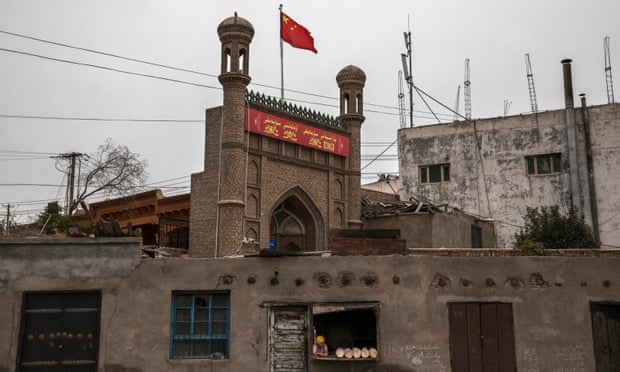by RACHEL HARRIS

A mosque in Kashgar, Xinjiang province, China. PHOTO/Kevin Frayer/Getty Images
The levelling of ancient sites in Xinjiang, alongside mass detention, is part of an attempt to destroy an entire society
Ten years ago, I started researching Islam among the Uighurs. I spent my summers travelling around the Xinjiang region in western China. I took long bus journeys through the desert to Kashgar, Yarkand and Kucha, slept on brick beds in family homes in remote villages, stopped off at Sufi shrines, and visited many, many mosques. My husband was working with me, and we dragged our kids along for the ride. The kids were quite small and not at all interested in our boring interviews with imams, and I bribed them with treats. I have a lot of photos of them sitting in the dust outside mosques, faces smeared with ice-cream, playing on their iPads.
It was an incredible time for mosque building in Xinjiang. After the Cultural Revolution, Uighur and Kazakh Muslims began to reconnect with their faith. They resumed the traditional practices of pilgrimage and festivals at the shrines that lie deep in the Taklamakan desert. They began to learn about Islam in the wider world; people who could afford it travelled to Mecca for the hajj, and they began to rebuild their mosques. As local communities grew richer they invested in bigger and more beautiful mosques; people crowded into them for Friday prayers, and they served as living symbols of community identity and pride.
I was reminded of all this by an image posted on Twitter last week. Shawn Zhang, who did pioneering work revealing the existence of the massive network of detention camps for Muslims in Xinjiang, posted “before and after” satellite images of Keriya mosque in the southern region of Hotan. This towering architectural monument, thought to date back to 1237 and extensively renovated in the 1980s and 1990s, was photographed on a festival day in 2016 with thousands of worshippers spilling out on to the streets. By 2018 the site where it had stood was a smooth patch of earth.
Observers have called China’s actions in Xinjiang the work of a “bulldozer state”. It is an apt way to describe the ongoing work of destruction and remodelling of the region’s landscape and its people. Mosques such as the one in Keriya were an early target of the campaign against “religious extremism”. A reporter visited the eastern region of Qumul in 2017 and learned from local officials that over 200 of the region’s 800 mosques had already been destroyed, with over 500 scheduled for demolition in 2018. Residents said that their local mosques had disappeared overnight, levelled without warning.
Mosques are not the only targets. Whole cities are being redesigned to facilitate maximum security and surveillance of the local population. Sites of architectural interest such as the ancient city of Kashgar have been demolished and rebuilt to suit the needs of what the government proclaims will be a flourishing tourism industry in Xinjiang. And it’s not just the built heritage that is being destroyed. The bulldozer is also at work on communities, culture and people’s lives. Everyday religious practice in Xinjiang has been effectively banned. People are plagued by tech surveillance technology – checkpoints, facial recognition software, mobile phone scanners – and intrusive visits to family homes identify individuals as “prone to extremism”. An official list of signs of extremism includes things such as refusing cigarettes and alcohol, not watching television and contacting people abroad.
The Guardian for more